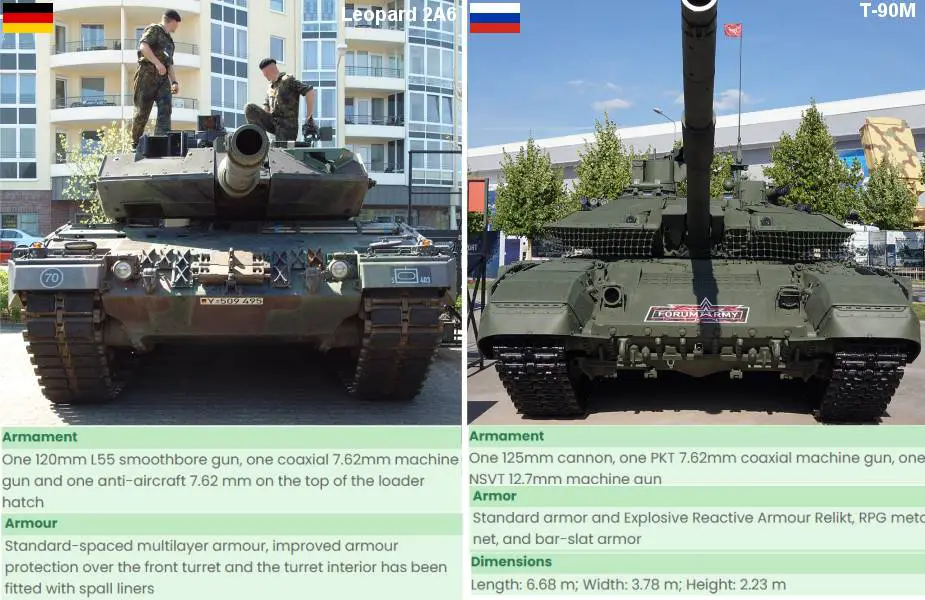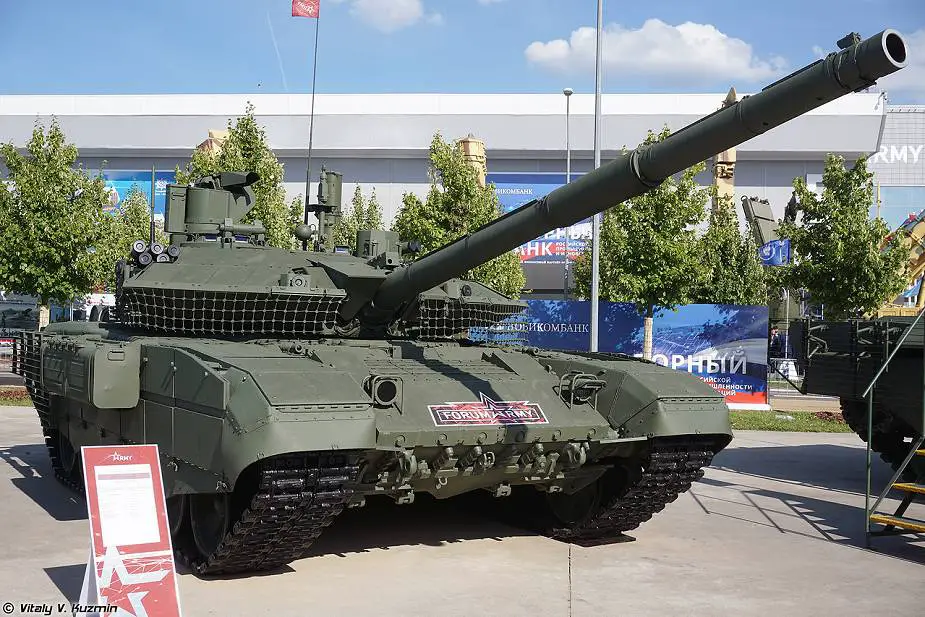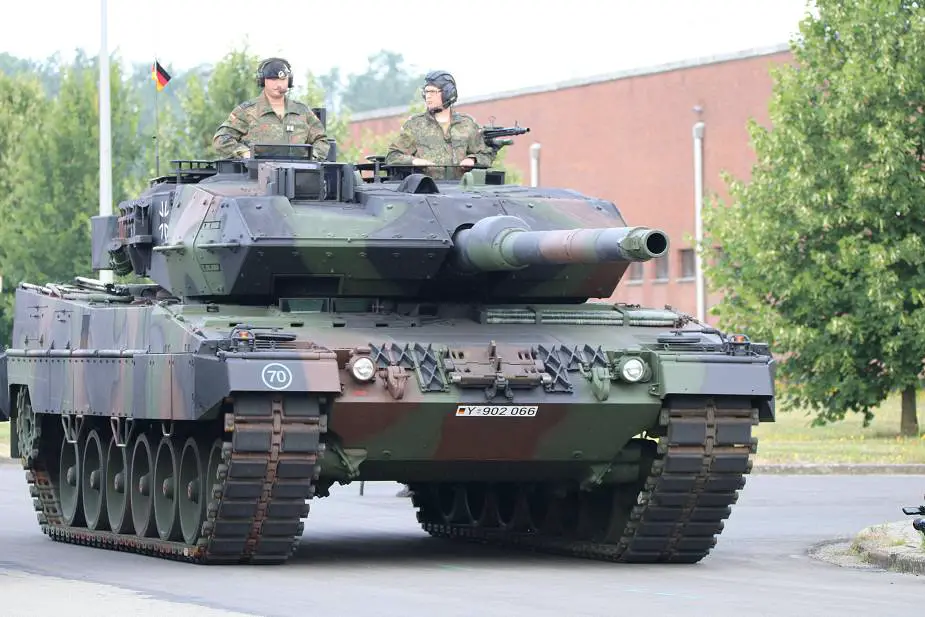Germany has delivered Leopard 2A6 tanks to Ukraine, which are considered among the best tanks in the world. In this article, the Army Recognition editorial team presents a detailed analysis and review of the advantages and weaknesses of the German Leopard 2A6 and the Russian T-90M tanks, which will soon face each other in future battles in Ukraine.
Follow Army Recognition on Google News at this link

Germany Leopard 2A6 VS. Russia T-90M MBTs Main Battle Tanks
The Leopard 2A6 is a German main battle tank (MBT) that has been continually upgraded since its introduction in the late 1970s. The Russian T-90M, also known as Proryv (Breakthrough), is a modernized version of the T-90, a Russian MBT that first entered service in the 1990s. When comparing the capabilities of the Leopard 2A6 and the T-90M, several factors can be considered:
The Leopard 2A6 is armed with a 120mm L/55 smoothbore gun, which provides improved accuracy and penetration capabilities compared to its predecessor, the Leopard 2A5. The T-90M features an upgraded 125mm 2A82-1M smoothbore gun, which is also capable of launching anti-tank guided missiles. Both tanks have advanced fire control systems, making them highly effective against enemy armor.
The Leopard 2A6 is powered by a 1,500 hp MTU diesel engine, giving it a top speed of around 68 km/h and a range of approximately 500 km. The T-90M is equipped with a 1,130 hp V-92S2F diesel engine, which provides a top speed of 60 km/h and a range of around 550 km. While the Leopard 2A6 has a slightly higher top speed, the T-90M has a marginally longer operational range.
The Leopard 2A6 has a reverse speed of up to 31 km/h, which is quite fast for a main battle tank. This reverse speed allows the Leopard 2A6 to quickly disengage from a dangerous situation or reposition itself for a better firing angle.
Compared to the T-90M, which has a reverse speed of around 21 km/h, the Leopard 2A6 has an advantage in maneuverability during combat scenarios. The faster reverse speed can provide a tactical edge by enabling the Leopard 2A6 to evade enemy fire, change positions, or withdraw from an unfavorable situation more quickly than the T-90M.
The Leopard 2A6 is equipped with advanced composite armor, which has been further enhanced with the addition of modular armor on the turret. The T-90M features the Relikt explosive reactive armor, which provides increased protection against modern anti-tank munitions. Both tanks can be equipped with APS (Active Protection System), such as the Leopard 2A6's Rafael Trophy system and the T-90M's Afghanit system, which can intercept incoming anti-tank missiles.
Both the Leopard 2A6 and T-90M have modern digital communication and data-sharing systems, allowing them to integrate with other units on the battlefield for improved situational awareness and coordination.
In conclusion, the Leopard 2A6 and the T-90M both possess advanced capabilities in terms of firepower, mobility, protection, and networking. While the Leopard 2A6 may have an edge in terms of firepower and mobility, the T-90M's upgraded armor and protection systems make it a formidable adversary. The outcome of a potential engagement between these two tanks would depend on various factors, such as crew training, tactics, and the specific combat situation.

Russian army T-90M MBT Main Battle Tank. (Picture source Vitaly Kuzmin)
While the German Leopard 2A6 is a highly capable main battle tank, it does have some weaknesses when compared to the Russian T-90M. In terms of protection, the T-90M is equipped with the Relikt explosive reactive armor, which provides superior protection against modern anti-tank munitions compared to the composite armor used on the Leopard 2A6. Additionally, the T-90M's Afghanit active protection system is designed to intercept incoming projectiles, further enhancing its defensive capabilities.
The T-90M has a lower profile than the Leopard 2A6, which can make it a more difficult target to detect and engage, especially in a hull-down position. This reduced visibility can provide a tactical advantage on the battlefield.
The T-90M has a crew of three including a commander, driver, and gunner thanks to the use of an automatic loading system. The reduced crew size allows for a more compact and lighter tank, which can contribute to improved mobility and a lower profile on the battlefield. The autoloader system used in the T-90M ensures a consistent rate of fire, regardless of the crew's fatigue or experience, unlike the manual loading process in the Leopard 2A6.
The loss of a crew member could have a more significant impact on the tank's overall effectiveness, as each crew member is responsible for multiple tasks. Some argue that autoloaders can be less reliable or slower than a well-trained human loader.
The T-90M features a 125mm 2A82-1M smoothbore gun, which also provides good accuracy and penetration capabilities. When firing modern APFSDS rounds like the 3BM59 Svinets-1 or the 3BM60 Svinets-2, the T-90M can engage targets at ranges of up to 4,000 meters (2.5 miles). Moreover, the T-90M has the ability to fire the 9M119 Refleks (NATO reporting name: AT-11 Sniper) anti-tank guided missile (ATGM), which can effectively engage enemy armor at long ranges. The 9M119 Refleks ATGM has a range of approximately 4-5 km and is designed to penetrate modern composite and reactive armor, making it a powerful weapon against enemy tanks. This missile capability gives the T-90M a significant advantage in terms of standoff range and versatility, allowing it to engage targets from a safer distance compared to conventional tank rounds. This capability is not available on the Leopard 2A6's 120mm L/55 smoothbore gun.
The T-90M has a slightly longer operational range than the Leopard 2A6, allowing it to cover more ground without needing to refuel. This advantage may be crucial in certain combat situations.

German army Leopard 2A6 MBT Main Battle Tank (Picture source Army Recognition)
The T-90M is the latest generation of main battle tanks designed and developed by the Russian defense industry. It also has some weaknesses when compared to the Leopard 2A6. In terms of firepower, the Leopard 2A6 is equipped with a 120mm L/55 smoothbore gun, which offers improved accuracy and penetration capabilities compared to the T-90M's 125mm 2A82-1M smoothbore gun. The longer barrel of the Leopard 2A6's gun can lead to higher muzzle velocities and better armor penetration at long ranges.
The Leopard 2A6 can fire kinetic energy penetrators like the DM63 APFSDS (Armor-Piercing Fin-Stabilized Discarding Sabot) round, it can effectively engage enemy tanks at ranges of up to 4,000 meters (2.5 miles).
The Leopard 2A6 is powered by a 1,500 hp MTU diesel engine, giving it a top speed of around 68 km/h, which is slightly faster than the T-90M's top speed of 60 km/h (37 mph) provided by its 1,130 hp V-92S2F diesel engine. This advantage in speed can be beneficial in various combat scenarios.
The Leopard 2A6 has a crew of four including the commander, driver, gunner, and loader. A dedicated loader can potentially achieve a faster rate of fire, especially if they are experienced and well-trained, but the tank is more dependent on the loader's performance, which can be influenced by factors such as fatigue or lack of experience.
The Leopard 2A6 has a faster turret traverse speed than the T-90M, which allows it to acquire and engage targets more quickly. This can be a crucial factor in fast-paced combat situations.
The Leopard 2A6 is generally considered to have better crew comfort and ergonomics compared to the T-90M. Better crew comfort can contribute to higher efficiency and endurance in prolonged combat operations.
It is important to note that these weaknesses do not necessarily imply that the T-90M is an inferior tank to the Leopard 2A6. The outcome of an engagement between these two tanks would depend on various factors, such as crew training, tactics, and the specific combat scenario. Moreover, the T-90M has its own strengths, such as superior protection and a lower profile, which could be decisive in certain situations.















